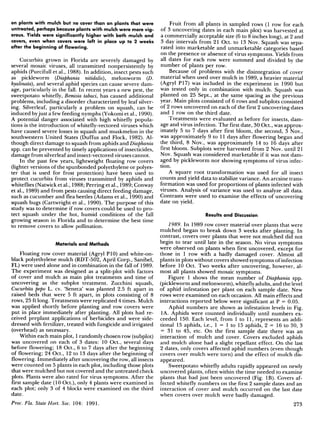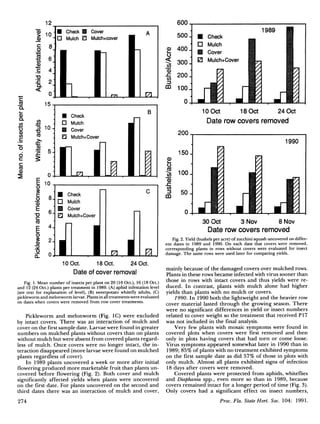The study assessed the effectiveness of cupric hydroxide and floating row covers in managing bacterial fruit blotch and insect pests in watermelon and zucchini crops. Treatments with cupric hydroxide significantly reduced fruit blotch symptoms and improved yields, while floating row covers effectively excluded insect pests and virus transmission, leading to higher marketable fruit yields. However, excessive applications of cupric hydroxide caused plant stunting and phytotoxicity, necessitating further research on optimal application timings.
![(Table 1). Symptom development was severe with the un-
sprayed treatments and 69% of the mature fruit had blotch
symptoms. Cupric hydroxide and cupric hydroxide plus
fosetyl-Al provided significant control of the disease, reduc
ing fruit blotch to 10% of the fruit. Streptomycin and
fosetyl-Al alone were not significantly better than the un-
sprayed control.
Yields of marketable fruit were significantly higher with
the treatments that received cupric hydroxide or cupric
hydroxide plus fosety-Al (Table 1). These yields were more
than 5 times the yields with no spray. However, there was
some stunting of vegetative growth with the application of
cupric hydroxide or cupric hydroxide plus fosetyl-Al. Six
applications of cupric hydroxide on watermelon resulted
in severe phytotoxicity in some situations. Therefore,
further experiments were run to determine whether fruit
blotch control was possible with 1 or 2 well-timed applica
tions of cupric hydroxide.
In the fall 1990 test, foliar symptoms of fruit blotch
spread rapidly through the plots after inoculation in Sept.
However, in Oct. and Nov., symptom development and
spread was minimal. Incidence of fruit symptoms was low
regardless of the number of applications of cupric hydro
xide (Table 2). Due to the low incidence of disease, there
were no significant differences among treatments. Plants
that received weekly applications were the only ones that
did not develop fruit blotch. Because of this, 2 additional
treatments that included applications prior to anthesis were
added to the spring 1991 test.
In 1991, foliar symptoms developed on all plants but
the disease stopped spreading 2-3 weeks after inoculation,
despite a very wet spring. Fruit symptoms were very limited
(Table 2). There were no fruit symptoms on plants receiving
weekly applications or on plants receiving 3 applications.
There were also no significant differences in marketable
yields among treatments. The lower yield with the treat
ments receiving weekly applications of cupric hydroxide
probably resulted from the stunted plant growth that oc
curred. No phytotoxicity was observed with any other treat
ment.
Table 2. Number and timing of cupric hydroxide applications for the
control of bacterial fruit blotch of watermelon.
Bactericide
application (no.) and timing7
Seven; weekly from 2 wk prior to
anthesis
Three; 2 wk prior to anthesis, at
anthesis, and 2 wk after anthesis
Two; 2 wk prior to anthesis and
at anthesis
Two; at anthesis and 2 wk after
anthesis
One; at anthesis
One; at first symptoms
Unsprayed
Fruit blotch (%)y
Fall 1990
0
NT
NT
4
10
5
15
Spring 1991
0
0
4
12
4
9
8
1991
Yield
(ton/A)
4.8
8.3
6.5
8.4
8.8
6.5
6.5
7Cupric hydroxide as applied at 1.0 lb/acre in 100 gal of water.
yPercent of the total fruit that have any fruit blotch symptoms. NT means
that the treatment was not tested.
Literature Cited
DeVos, P., M. Goor, M. Gillis, and J. DeLey. 1985. Ribosomal ribonucleic
acid cistron similarities of phytopathogenic Pseudomonas species. Int.
J. Syst. Bacteriol. 35:169-184.
Hopkins, D. L. 1989. Bacterial fruit blotch of watermelon: a new disease
of watermelon, p. 74-75. In: C. E. Thomas (ed.). Proc. cucurbitaceae
89: Evaluation and enhancement of cucurbit germplasm symposium.
29 November - 2 December, 1989, Charleston, SC.
Hopkins, D. L. 1990. Differences in cultivar resistance to bacterial fruit
blotch of watermelon. Phytopathology 80:435 (Abstr.).
Latin, R. X., and K. K. Rane. 1990. Bacterial fruit blotch of watermelon
in Indiana. Plant Dis. 74:331.
Schaad, N. W., G. Sowell, Jr., R. W. Goth, R. R. Colwell, and R. E. Webb.
1978. Pseudomonas pseudoalcaligenes subsp. citrulli subsp. nov. Int. J.
Syst. Bacteriol. 28:117-125.
Somodi, G. C., J. B. Jones, D. L. Hopkins, R. E. Stall, T. A. Kucharek,
N. C. Hodge, J. C. Watterson, and D. Randleas. 1991. Occurrence of
a bacterial watermelon fruit blotch in Florida. Plant Dis. 75:1053-1056.
Wall, G. C., and V. M. Santos. 1988. A new bacterial disease of watermelon
in the Mariana Islands. Phytopathology 78:1605 (Abstr.).
Webb, R. E., and R. W. Goth. 1965. A seedborne bacterium isolated from
watermelon. Plant Dis. Reptr. 49:818-821.
Proc. Fla. State Hort. Soc. 104:272-275. 1991.
FLOATING ROW COVERS EXCLUDE INSECTS
AFFECTING FALL-GROWN SQUASH IN CENTRAL FLORIDA
Susan E. Webb
Central Florida Research and Education Center
IFAS, University of Florida
5336 University Avenue
Leesburg, FL 34748-8203
Additional index words, aphids, sweetpotato whitefly, Bemisia
tabaci, pickleworm, melonworm, Cucurbita pepo, Diaphania
spp.
Florida Agricultural Experiment Station Journal Series No. N-00504.
I thank American Agrifabrics and April Corporation for donations of
material and D. Yadon and K. Kelley for technical assistance.
272
Abstract. Spunbonded polyethylene floating row covers were
evaluated for effectiveness in excluding aphid-vectored vir
uses, whiteflies, (Bemisia tabaci [Gennadius]), pickleworm,
(Diphania nitidalis Stoll), and melonworm, (D. hyalinata L.)
from zucchini squash {Cucurbita pepo L.) In 1989 and 1990,
a lightweight cover (Agryl P10, American Agrifabrics, Al
pharetta, Georgia) and white on black polyethylene mulch
were used alone and in combination. The effect of the date
of cover removal on yield was also determined. In 1990, a
heavier material (Agryl PI 7) was tested only in combination
with mulch. Both materials effectively excluded insects. Mosaic
viruses vectored by aphids were rarely found when plants
were first uncovered, although most plants developed virus
symptoms within 2 or 3 weeks after uncovering. In 1989, more
Diaphania larvae and, in 1990, more whiteflies were found
Proc. Fla. State Hort. Soc. 104: 1991.](https://image.slidesharecdn.com/ywh59-150201155016-conversion-gate02/85/Floating-Row-Covers-Exclude-Insects-affecting-Fall-Grown-Squash-Gardening-Guidebook-for-Florida-1-320.jpg)


